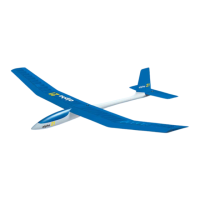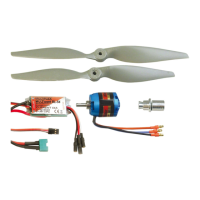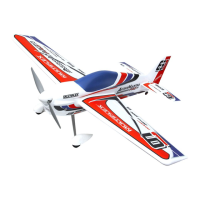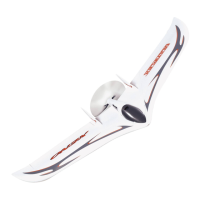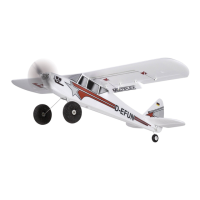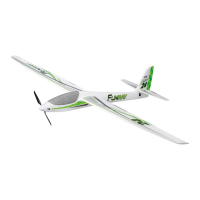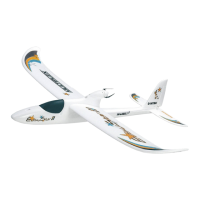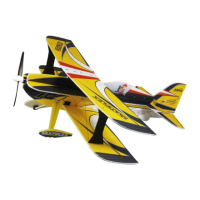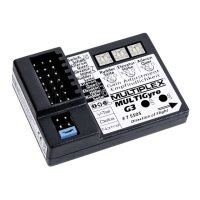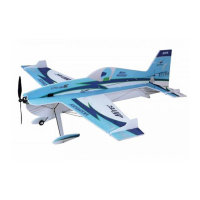Slide
the
assembled
clamp
onto the
two rectangular
brass
tubes
20. N.B.
-the
clamplng
screw
26
must never
be tlghtensd
wlthout the stesl
blade3
In
plaqe!
Slide
the side
pieces
21
in
place, noting that
the R H
wing blade
must be
located
In
front of the
L.H. blade
when
the wing
ioiner
is
installed
later' The
markings
on
the fuselage
and the support
boxes
in the
wings are
laid out
for
this
arrangement.
lf
you
make an error
here, il wilt
prove
impossible
to
assemble
the model.
You now
have to decide
how much dihedralto
use
On the
prototypes
we have
found
3.5"
perwing to be
ideal. Ityou
intend using
the modelfor
thermalflying
on the
flat,
we suggest
4.0"
per
wing With
less than 3.5"
per
wing, the model
has a tendency
lo skid,
and drag-producing
conlrolsurface
correctoins
haveto
be used
to counter
this
tendency.
With
more than 40
per
wing,
the model
is
more inherentlv
stable,
and
does not
respond so
wellto lhe controls.
Please
note that
the Alpina's'
outboard
wing
panels
have extra
dihedral
built
in. lf
you look along
th€
leading edge of
the wing'
you
will see
that the second
tapeied
section
is angled
upwards
slightly.
This la Intenllonaland
has
proved
very uselul
in
'Alpina's'
many
predecessors
and
prolotypes.
The dihedral
ol
the
wings is determined
by
the spacing
of the side
pieces
21
:
76
mm
=
3.0 degrees
per
wing
65
mm
:
3.5
degrees
Per
wing
57 mm
=
4.0 degrees
per
wing
50
mm
:
4.5 degrees
per
wing
Markthe
centre on
the brass
tubes, and
fitthe side
pieces2l
equidistanl
from
the centre,
and at
the correct
spacing.
Fix them
in
position
using
slow-setting
epoxy
or- better-
solder€d
ioints.
Slide
the clamp away
from
the area
when
soldering.
The wing
ioiner
is now
permanently
attached
to the fuselage
and
you
should
work
very carelully
here.
Both wings
are
needed lor this
job.
Fit the wing
joiner
unil
into the
fuselage and
plug
both
wings
in You
may find it
necessarylo
open
out one
or both slots
downwards,
according
to
the djhedral
you
nave cnosen.
Checkthe
wings'alignment
to thefuselage
lhis is correctwhen
the
wing root
airfoilisflush
with lhe
fuselage
wing tairing
Adiust the slots
until
this is so
lfthe
rear dowel
holes
need to
be adjusted,
dothis as
foliows:file
outthe
holes until
the
wings
fit accurately
to lhe
fuselage.
When the
wing
ioiner
unit
is
glued
in
place,
these
holes can
be
masked otf, and
lilled
with s-minute
epoxy
from the
inside. When
the epoxy
has
thoroughly cured
(overnight) lhe holes can
be re-
drilled in
the correct
location.
When both
wings
fitcorrectly,
the
wing,oiner unit-with
clamp
in
place-can be
spot-glued
in
position
with afewdrops
ofs-minule
epoxy On
noaccountuse
such
an adheslve
lor
gluing
the
whole
unlt In
place.
In the
long term
the
joint
would
not stand
up to
the loads
placed
on
it When the epoxy
has cured
completely,
carelully
remove
lhe
wangs
Sealoffthe
open
end of
the brass
tubes on
the outside.
Lay ihe
fuselage down
on its side
and
hold
it in
place.
Apply slow'setting
epoxy
around
thejoiner
unit
inside
the
fuselagel
the epoxy
-
or laminating
resin
-
can
be thickened
with
micro-balloons
so
that better
fillets are
lormed
The
fuselage
must nol be
mov€d untilthe
resin has completely
cur€d,
to
prevent
any
resin
getting inside
the brass
tubes.
Repeat
for the other side.
lmpodant:
The bonded-in
bowden cable
guide
lubes are
hsat-sensitive
The
geicoat
pigmentshould also not be
heated
uptoo
much, and
consequently
you
ahould
not
use a
temperature
higher
than about
50"C to
accelerate
the curing
ol the
resin!
Sand
the
vertical
faces ot
the luselage
wing
fairings and
check
that they
are
quite
flat.
This completes
the
fitting of
the wing
joiner
unit.
The servo
plates
and lormers
are fitted
next.
Servo
plates
30
and 31
can be checked
for fit
in the tuselage,
and
the edges
bevell;d
to match
th€ curyature.
lvlark the
posilion ol the
ply
parts
in the
fuselage,
and
roughen
up the
fuselage side
walls.
lf
you
are
using a
MULTIPLEX
R/C system,
you
can transler
the
position
olthe
s;rvo
cut-outs
directly
from the
plan
lf
you
are
using a
ditlerent
make ol
radio,
use the
appropriate
servo
mount dimensions
lor these cut-outs'
Use
servo
clips O./No.
8
7o7o tor
MULTIPLEX
servos
(not
supplied),
and
screw
them
lo the servo
plates.
lfyou are
fining an
aero-tow
mechanism,
note
that this
servo
has to be
fitted 3
m m.
higher, mounted
on scrap
plywood
The firstjob
is to tit the aileron/airbrake
servo
plate
intothe
tuselage
Tofindthe
correct
position,
slide
the
aileron and
airbrake
pushrodsand
innersleeves
Into
the wing
tubes,
leaving
about 30
m.m
projecting
at the
root end
Plug the
wings onto
the
fuselage, and
slide
the servo
plate
into the
fuselage'
MoJe
the
ptäte
until
the
pushrods
from
the
wings coincide
exactly
with
the
Dosition ot
the servo
outputarms.
Nole
howthe
pushrods
are connected
to the
aileron seryo
on the
plan;
this arrangement
in conlunction
with
lhe
rest
of
the
aileron
linkage
providesthe required ditlerential
movement of the ailerons
For
aerodynamic
reasons it
is
desirable
to
have more
movement up than down
The
ratio
should
be about
% up and %
down.
A simpler,
and more
precise
method ol
achieving
this is to use servo output
device
O./No.
08 521
1, which is specially
designed
for this
purpose.
When the servo
olate
is correctly
located, secure
it,,vith a lew drops ol5-minule
epoxy, as
with lhe
wing
joiner
unit.
Ityou are
fitting an aero{ow
mechanism,
drilla3 m.m.
hole inlormer32where
ma.ked.
Check servo
plate
31,
former 32 and
haltformer 33
forfit in thefuselage, align
them carefully,
and
fix in
place
with
a
fewdrops ol5-
minute epoxy. Be sure
that
these
parts
do
not distorl
the luselage.
Before
permanenlly gluing
the
ply parts
in
place,
check
the followingi
a Do the
pushrods lrom the wings
line
up
exactly with
the
servo
output arms?
a
ls
servo
plate
31
horizonlal and
correctly located?
a
Do the lormers
and servo
plales push
the
luselage sides apart?
You can
checkforthis
by
placing
thecanopylrame bonom
part
in the
canopy
cut-out'
after bevelling
the
front and rear ends
as
per plan.
a Can
you
easily
fit
and
remove
the
battery
and
the receiver?
ll necessary,
make adjustments
until all is
well.
Using
a slow- settang
epory,
thickened
with micro-balloons
if
desired,
glue
all
the
ply parts
securely
in
oosition.
Bemove the servos
belore applying
the
gluel
When the
glue has
completely
cured,
the bowden
cable
guide
tubes
\-.,
elevator
and
rudder are brought
to lhe correct
posilion.
Drill3 m.m.
holes in
tube suooorts 38
and thread
them onto the
tubes. Fil the servos
into their
cut'
outs.
Glue the
tube supports
and tubes
to lormer 33,
with the lubes aligned
exactly
with the servo
output arms.
Form a
generous
epoxy
fillel where the
tubes
pass
lhrough
the supports.
It
you
are
installing an
aero-tow
mechanism,
follow the suggestions
on the
plan.
This type ofcoupling
has
proved
excellenl
in thousands
of
launches, not
least because
of
ils
simPlicity.
File a slot,
no
morethan 2
x 4m.m.long,
in thefuselage
nosewhere shown.
To
dothis,
pilotdrillwith your
smallest drill,
and
file
oul
to size using
a smallneedle
lile. Cut bowden
cable
guide
tube
39 to
fit lhe fuselage shape'
and
pass
it
through the
pre-drilled
hole in the
former. Bend
lhe end ofthe
operatang
rod lo
shape
(see
plan)
and
tit it
into the tube.
The rod will slide
more easily
if it is
curved
to match
the
guide
lube. Glue
theguidetube
in
place, placing
apiece of
scrap
wood between
the luselage
side and
the tube
The operating
rod should
appear exactly
in the cenke
of the slot
Apply
more resin
to the lube
to ho'd it
firmly
in
place.
Cutthe
operating
rod exactlylo
length. Connect
the
rod to the
innermost hole
in
lhe servo
output
disc, ano
lnm lhe
servo exaclly
to cenhe'
as shown
on lhe
plan.
Theend
ol the
rod must be
visible through
the slot.
Check
that the system
works correcllv.
The canopy
is assembled
next. Bevel
pads
34 to 36
as
per plan,
and fit lhet.-.--
together'dry'
on
the luselage.
Roughly
bevel
the outside
edges to
match the
fuielage shape.
Glue
the
parts
together
on the
fuselage,
using a
piece
of
plastitfilm
under
the
parts
lo
prevent
them sticking
to the luselage
(Jll.3)
Carelully
cut
out the
canopy
41 along the
marked
lines.
When the canopy
frame
is
dry,
carefully
sand
the outside
edges
to match
the fuselage shape'
and try
the canopy
tor
fit. The lit of
the canopy
should be
adiusted
until the
fuselage
and canopy
lorm
one smoolh,
continuous
line.
Before
gluing
the
canopy
to the
frame,
paint
or cover
the frame
with film
The canopy
is
glued
to
the frame using
contact
glue:
this is the
procedure:
Attach
the'ha;e
to
the
fuselage wilh
a few small
svips
ol double-sided
sellotape.
Check
that
it is exactly
in the
right
position
lt must be
possible to
release the
canopy
floor
later! Apply a thin
coal of
contact
glue
to the canopy
and
immedlately
place it on the
trame. Do
not letthe
glue
dry'
This allows
the
canopy
to be
moved
around until
it fits correctly
Hold it in
place
wilh strips
of
tape,
and
let the
glue
dry out overnight.
Remove
the tape
and carefully
prise
the canopy
trame
from the
tuselage
Remove
any excess
glue,
and
trim the
canopy
il necessary.
The
canopy
locator
3T
is atiached
next: tile a slol
in the
fuselage
where shown
on
the
plan,
only
just
wide enough
to take
the
locator.
Clamp
the
locator
into the slot,
flush
with the canopy
support
surface
Apply
qlue
to the
pad
which
projects
downwards
Place
the canopy
accurately
in
;osrt|on. and
secure
with tape.
Caretully
push
the
locator
lorward
onlo
lhe
canopy
frame, using
a
piece
ol
wire through
the
pushrod holes in lhe
root
fairing:
Let the
glue
dry,
remove
the canopy
and apply
a
fillet ol
glue
to the
locator.
12
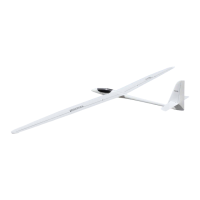
